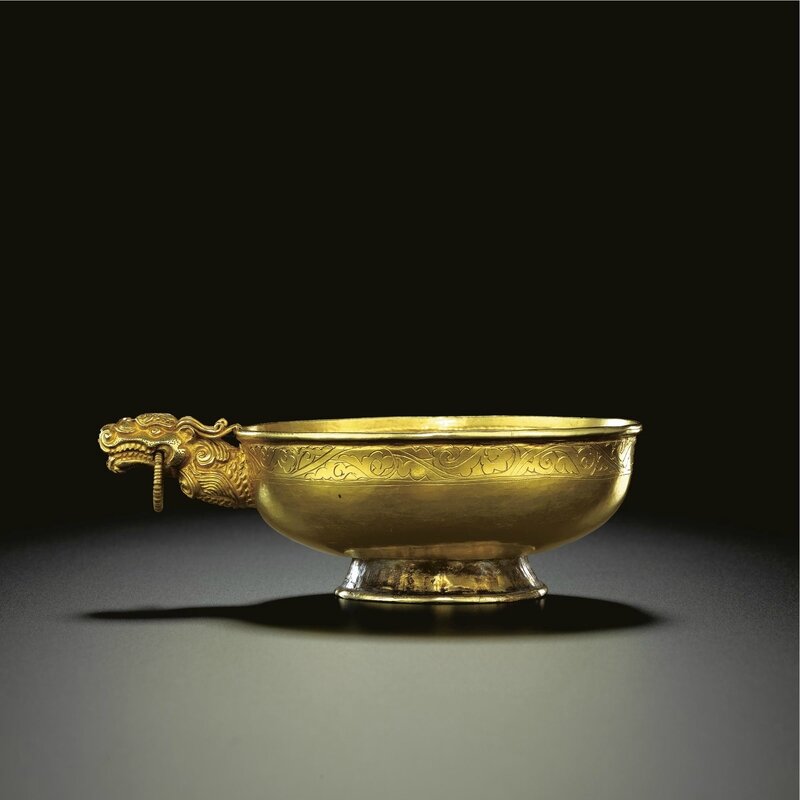A fine and rare gold cup, Song dynasty (960-1279)
Lot 104. A fine and rare gold cup, Song dynasty (960-1279), 8.3cm., 3 1/4 in. Estimate 15,000 — 20,000 GBP. Lot sold 692,500 GBP. Photo: Sotheby's.
the shallow bowl with rounded sides rising from a gently splayed foot, the interior finely engraved with a central medallion of flowering foliage with stems of peonies set with large feathery leaves, a band of scrolling palmettes engraved below the lipped rim on the exterior, set on one side with a handle realistically rendered as a dragon's head, the tufted brows sweeping back to pointed ears and horns, nostrils flared and the jaws open wide showing large teeth and holding a ring, weight 72g.
Exhibited: Chinese Gold and Silver in the Carl Kempe Collection, Smithsonian Institution, Washington, D.C., 1954-55, cat. no. 53A.
Chinese Gold, Silver and Porcelain. The Kempe Collection, Asia House Gallery, New York, 1971, cat. no. 22, an exhibition touring the United States and shown also at nine other museums.
Literature: Bo Gyllensvärd, Chinese Gold and Silver in the Carl Kempe Collection, Stockholm, 1953, pl. 53A.
R. Soame Jenyns and William Watson, Chinese Art. The Minor Arts, Fribourg 1963, pl. 14.
Zhang Linsheng, 'Zhongguo gudai di jingjin gongyi', The National Palace Museum Monthly of Chinese Art, 1984, no. 14, p. 59, fig. 32.
Chinese Gold and Silver in the Carl Kempe Collection, The Museum of Art and Far Eastern Antiquities in Ulricehamn, Ulricehamn, 1999, pl. 50.
Chinese Ceramic Treasures, The Museum of Art and Far Eastern Antiquities in Ulricehamn, Ulricehamn, 2002, pl. 50.
Note: Song gold pouring vessels of this form are extremely rare with the present cup the only recorded example of its type. The form of this cup, with the handle in the shape of a dragon's head, is reminiscent of yi vessels where the handle is replaced by a spout. The present cup is possibly inspired by earlier, Tang period, gold examples, such as the two cups, of different form, but also made of pure gold, found amongst the treasures of Prince Bin, excavated at Hejiacun, south of Xi'an in Shaanxi province, now in the Shaanxi History Museum, illustrated in Zhongguo jin yin boli falangqi quanji, vol. 2, Shijiazhuang, 2004, pls. 22 and 23, the former of tripod form with a handle, the latter of a shallow bowl form with a spout.
A large silver cup of related form with a ring handle, from the collection of Dr. Pierre Uldry, was included in the exhibition Chinesisches Gold und Silber, Rietberg Museum, Zurich, 1994, cat. no. 126. See also a silver yi from the storing site at Hejiacun, in the Shaanxi History Museum, Xi'an, published in Sekai bijutsu taizenshu: Toyo hen, vol. 4, Tokyo, 1997, pl. 164; and another silver vessel excavated in 1992 at Nandan county, Guanxi province, illustrated in Han Wei and Christian Deydier, Ancient Chinese Gold, Paris, 2001, pl. 430.
Sotheby's. Masterpieces of Chinese Precious Metalwork, Early Gold and Silver; Early Chinese White, Green and Black Wares, London, 14 May 2008

/https%3A%2F%2Fprofilepics.canalblog.com%2Fprofilepics%2F1%2F0%2F100183.jpg)
/https%3A%2F%2Fstorage.canalblog.com%2F03%2F02%2F119589%2F96711876_o.jpg)
/https%3A%2F%2Fstorage.canalblog.com%2F11%2F31%2F119589%2F94773502_o.jpg)
/https%3A%2F%2Fstorage.canalblog.com%2F20%2F83%2F119589%2F94772815_o.jpg)
/https%3A%2F%2Fstorage.canalblog.com%2F26%2F72%2F119589%2F75604929_o.jpg)
/https%3A%2F%2Fstorage.canalblog.com%2F59%2F60%2F119589%2F26458628_o.jpg)



/image%2F1371349%2F20240415%2Fob_308536_436292768-1650079115762101-83406494688.jpg)
/image%2F1371349%2F20240408%2Fob_b3fc19_435359290-1647758335994179-79867038222.jpg)
/image%2F1371349%2F20240406%2Fob_9e792c_435377691-1644764672960212-80619555723.jpg)
/image%2F1371349%2F20240406%2Fob_d1f50a_436272281-1646702666099746-69647680342.jpg)